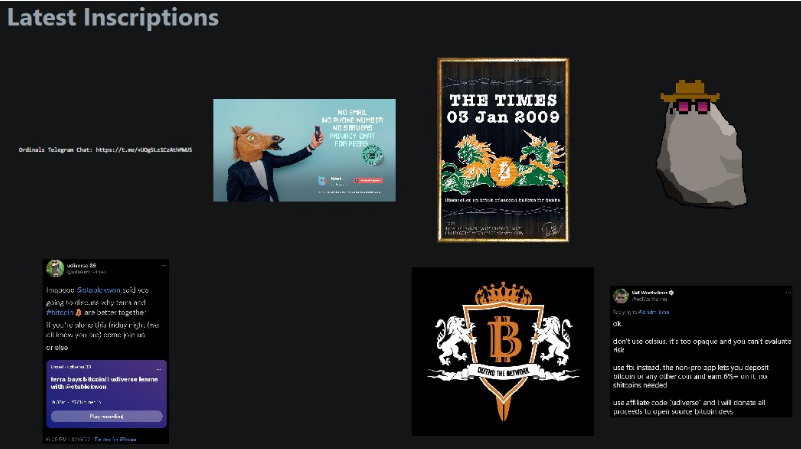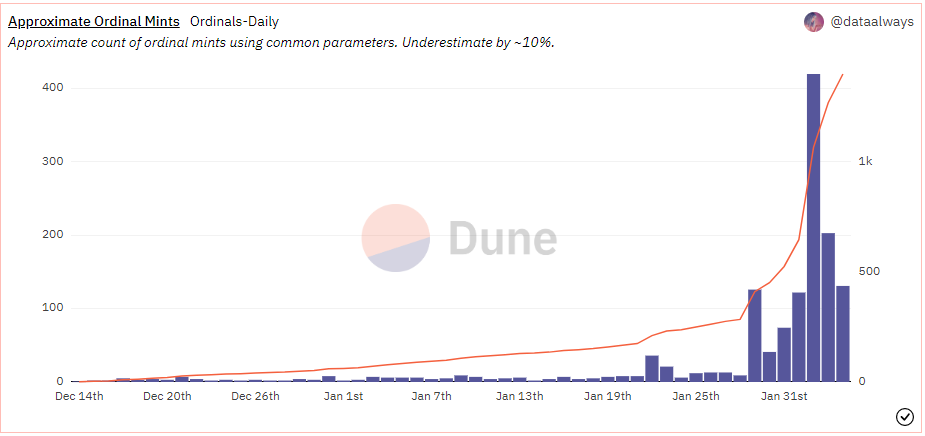References for this article | Cointelegraph & forkast

Bitcoin is currently the largest cryptocurrency blockchain in the world, but there is one use case that is rarely seen on the Bitcoin chain: NFTs. NFTs, or non-fungible tokens, are one of the hottest use cases on the Ethereum blockchain, generating over $36 billion in on-chain transactions to date. However, some encryption practitioners hope to change this situation and launched a new agreement. It is unexpected that the construction of the NFT agreement on Bitcoin has caused dissatisfaction in the community.
On Jan. 30, "Ordinals," an NFT protocol created by software engineer Casey Rodarmor, officially launched on the Bitcoin mainnet, allowing users to create Bitcoin versions of NFTs -- described on the Bitcoin network as "digital artifacts." artifacts)" to support JPEG image, PDF, video or audio format content. Similar to many NFT items on the Ethereum chain, these "digital artifacts" will be minted on the Bitcoin network.

Minting NFTs on Bitcoin's Chain Sparks Controversy
As the creator of the Ordinals protocol, Casey Rodarmor explained that the protocol’s NFTs are created by writing arbitrary content on “satoshi” (Satoshi, the native currency of the Bitcoin network).
According to the description of the Ordinals protocol document, all "satoshi" written into the NFT content can be saved or transferred to other Bitcoin addresses, and the transaction will display the inscription content on the Bitcoin blockchain, which has thousands of "staoshi" content. Inextricably linked, the Ordinals protocol will turn these contents into an immutable "digital artifact" product, and allow users to track, transfer, store, buy, and sell. Inscriptions will be minted on the Bitcoin mainnet, no need for sidechains and other tokens - in short, users can insert large amounts of "data/content" into transactions through the Ordinals protocol, including creating collectible "pictures" on the network ".
Generally speaking, when the NFT protocol/project is launched on the Ethereum chain, there will always be a wave of community attention and trading enthusiasm, but after the release of the Ordinals protocol, controversy broke out in the Bitcoin community. Some people believe that the NFT protocol can provide Bitcoin with more Many financial use cases, while others say it deviates from Satoshi Nakamoto's vision of Bitcoin as a peer-to-peer cash system, and NFT may occupy block space on the Bitcoin network, thereby driving up transaction fees. Not only that, but the "opponents" of Bitcoin NFT also believe that NFT avatars are a privileged status symbol that only wealthy investors have the opportunity to obtain. If network fees increase significantly, more people will be excluded from Bitcoin. Outside the network, it is not conducive to driving encryption adoption.

However, some people are optimistic about the Bitcoin NFT market. Former Kraken executive Dan Held is one of the supporters of the Ordinals protocol. He believes that although the NFT protocol will increase the demand for Bitcoin block space and increase transaction costs, it will also increase Bitcoin. Bring more financial use cases, "If you pay transaction fees, it's a 'junk' transaction, Bitcoin is permission-free, and in any case can't stop anyone from BUIDLing on the Bitcoin chain."
In addition, with the launch of Segregated Witness (SegWit) in 2017 and the launch of Taproot in 2021, Bitcoin today can fully satisfy protocols like Oridinals to expand NFT functionality on the network.
Breaking the Ethereum NFT monopoly?
NFT is considered an important part of reimagining the Web3 Internet. Games, social media, and financial services can all meet user needs through NFT. But the problem is that NFT has long been "occupied" by Ethereum, and the blockchain already has about 70% of the value of NFT sales.
For a long time in the past, many blockchain networks (such as Cardano, Solana, Polygon, etc.) have been labeled as "Ethereum killers" and hope to get a share of Ethereum's market share in Web3 or NFT , but so far the effect is not obvious.
Yehudah Petscher is an NFT relationship strategist at CryptoSlam, a blockchain data aggregation service platform. He believes that the Bitcoin blockchain can break Ethereum's NFT monopoly through its "historical advantages." "Bitcoin has existed longer than any other cryptocurrency." Both have a long history and have a large user base. So in terms of adoption, Bitcoin can compete with Ethereum in the NFT space faster than other blockchains.”
What's next?
What's next?
According to data from the blockchain analysis platform Dune Analytics, the Ordinals protocol has minted more than 1,000 NFTs so far, and this Thursday (February 2) minted 420 NFTs, setting a single-day highest minting record, while the average transaction of the Bitcoin network Fees hit $1.53 on the same day, the highest since Dec. 27, 2022. According to Hashrate Index data, when Ordinals was launched on January 21, the highest percentage of network transaction fees in miners’ block rewards was 2.1%; rose to 3.86%.

The numbers don’t lie, and transaction fee increases are indeed a side effect of NFTs being added to the Bitcoin mainnet. Bitcoin transaction fees depend on the amount of data in the transaction and the speed at which the user wants to complete the transaction. Once network traffic increases, users who want to prioritize transactions need to pay more to push the transaction to be confirmed in advance.
However, the real change that Ordinals will bring to the Bitcoin network may not be just to create new types of digital collectibles, but to prove that developers can "BUDIL" on the oldest blockchain and change market dynamics. Although "Bitcoin maximalists" have always insisted on Satoshi Nakamoto's original intention of making it a peer-to-peer electronic currency, the Ordinals protocol has undoubtedly made the Bitcoin network more practical.
Strictly speaking, NFT is also a financial asset, and Bitcoin can fully support the exponential growth of such assets on its network, even if there is a risk of driving up regular transaction fees. What's more, the additional effect of using BTC to trade NFTs may also further increase the price of BTC, which means that both miners and long-term holders can benefit from it.
Overall, the Ordinals protocol is a positive development for the Bitcoin network. Whether BTC will always be a "peer-to-peer electronic currency" is determined by the community and users, and it is unrealistic to limit the use cases of Bitcoin. In fact, people have been exploring and experimenting with Bitcoin since its inception, otherwise there would be no second-layer solutions like the Lightning Network-after all, nothing is impossible in the decentralized world.